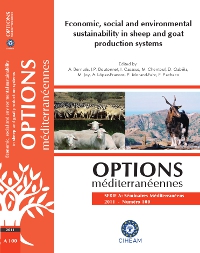| Article précédent | p. 289-292 | Article suivant |
Effect of number of utilizations in a barley grass in Mediterranean conditions on biomass production and the admissibe stocking rate of Majorcan red sheep
Majorcan Red Sheep is an endangered sheep breed and its conservation depends on the availability of feed resources and its use for feeding them. Animal production is considered a multifunctional activity due to its implication in economic, ecological and social aspects, which are strongly linked to its sustainability. The Majorcan Red Sheep production system has been directly linked to the exploitation of agricultural production. There is a clear positive economic impact when forage resources are used appropriately. The aim of this study was to determine the effect of the number of uses (1 to 3) on the herbage production of a barley crop and to estimate the suitable stocking rate. Results from this study showed that increasing the number of usesfrom 1 to 3 allowed greater production of forage (1863 vs 3274 Kg DM/ha), crude protein (113 vs 528 kg CP/ha) and more energy (3546 vs 8047 Mcal ME/ha). Therefore the suitable stocking rate is greater when a forage barley crop is used 3 times.
La brebis Roja Mallorquina est une race autochtone en danger d'extinction dont la conservation dépend, entre autres facteurs, d'une meilleure valorisation des ressources qu'elle utilise. La multifonctionnalité de sa production est due à ses atouts économiques, écologiques et sociales, et est pleinement en rapport avec son caractère durable. Dans ce contexte, la production de cette race est directement liée à la valorisation des pâturages. C'est pour cette raison que l'on a étudié l'effet du nombre d'utilisations (1, 2 ou 3) sur la production de biomasse d'un pâturage d'orge et que l'on a estimé la charge admissible de brebis Roja Mallorquina. Dans les conditions agronomiques de l'étude, le fait de passer de une à trois utilisations a permis d'obtenir plus de biomasse (1863 vs 3274 kg MS/ha), plus de protéine (113 vs 528 kg/ha) et davantage d'énergie (3546 vs 8047 Mcal EM/ha). Tout ceci fait que la densité animale admissible est plus élevée lorsque l'on réalise trois utilisations.
- [ Afficher ]
- [ Télécharger ]
- [ Exporter la citation ]
Vous pouvez télécharger la citation au format :
- [ Imprimer ]
-
Mots-clés
BIOMASSE, BREBIS, CAPACITE DE CHARGE, DONNEE DE PRODUCTION, DURABILITE, OVIN, PATURAGE, RACE INDIGENECiter cet article
Jaume J., Moya J., Joy M., Cifre J., Rovira J., Joy S. Effect of number of utilizations in a barley grass in Mediterranean conditions on biomass production and the admissibe stocking rate of Majorcan red sheep. In : Bernués A. (ed.), Boutonnet J.P. (ed.), Casasús I. (ed.), Chentouf M. (ed.), Gabiña D. (ed.), Joy M. (ed.), López-Francos A. (ed.), Morand-Fehr P. (ed.), Pacheco F. (ed.). Economic, social and environmental sustainability in sheep and goat production systems. Zaragoza : CIHEAM / FAO / CITA-DGA, 2011. p. 289-292. (Options Méditerranéennes : Série A. Séminaires Méditerranéens; n. 100). 7. Proceedings of the International Seminar of the Sub-Network on Production Systems of the FAO-CIHEAM Inter-Regional Cooperative Research and Development Network on Sheep and Goats, 2010/11/10-12, Zaragoza (Spain). http://om.ciheam.org/om/pdf/a100/00801517.pdf



